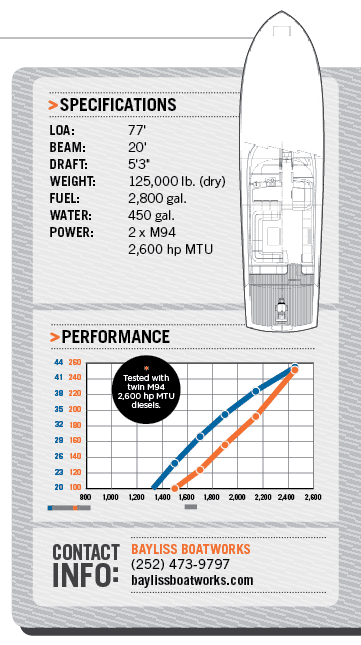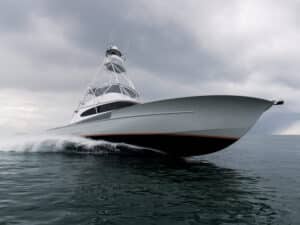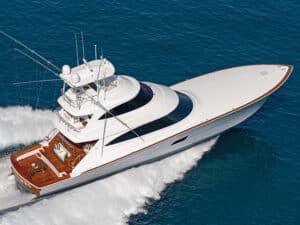
While the ideas of renowned physicist Albert Einstein changed the world, he was never, to my knowledge, a sport-fishing enthusiast. However, he did have a thought that might explain how John Bayliss achieved a remarkable accomplishment with Bayliss hull number 18, the 77-foot Clean Sweep.
Einstein’s quote goes like this: “You have to learn the rules of the game. And then you have to play better than anyone else.”
Bayliss learned his boatbuilding in that special enclave of Carolina boatbuilders. “For me, growing up in that environment, it was always fishing first,” he says as we discussed his early days on the water and his -eventual graduation, with honors, from “Oregon Inlet University.”
It wasn’t until mid-2001, when he was asked to offer some insight into a build, that Bayliss decided it was time to do something on his own. “I had a lot of ideas in my head and ran things up the flagpole with a couple of friends,” he says. By Christmas week of that year, ground was broken for the shop. Eighteen boats later, the Bayliss brand has become a formidable force in the rarefied air of hard-core, custom-built sport-fishing machines.

Engine Room
“Everything is important aboard our boats,” Bayliss says. “From the top of the tower to the bilges, nothing gets less attention just because it can’t be seen.” I like to start at the bottom when reviewing a boat, knowing that if things are taken care of there, the rest will follow suit. I entered the machinery space via a large hatch on the cockpit’s centerline where a set of steps allows easy access without any serpentine contortions.
Brightly lit with high-gloss refrigerator-white finishes on all the big iron and its requisite equipment, the fully air-conditioned and wired for sound engine room offers complete access to any piece of equipment. “Makes it a pleasure to work down here, what with the AC and some music,” remarks Capt. Gerry Keene, _Clean Sweep’_s skipper and a 13-year veteran with these owners, having been with them on their previous Bayliss boat, hull number 8, as well.
Fully forward and through a door is the pump room with all water and air‑conditioning systems, and their redundant backups, to port and starboard, respectively. As with the engine room, there is great working space in here as well, whether you’re accessing the mains or the pair of 30-kW Northern Lights gensets. A pair of 2,600 hp 16V 2000 MTUs power Clean Sweep.

Cockpit
As you would expect, the as-good-as-it-gets business end of Clean Sweep is her 200-square-foot cockpit. It is replete with mezzanine, fish boxes, livewell, chillers, individually controlled refrigerator and freezers, cold-drink compartment, tackle storage, amazingly detailed and expertly finished teak covering boards and deck, a beautiful fighting chair, actuated under-gunwale storage cabinets, and just about anything else a tournament-ready sport-fishing yacht would need to get the job done.

Interior
Clean Sweep features a striking ice-blue hull and white house, with a teak toe rail, a dramatic hull form and a balanced Carolina profile — and that was merely a prelude of what would await within. “Her owners are big-time fishing people and have a shared vision on how they want to use their boat,” says Keene.
Clean Sweep presents a four-stateroom, four-head layout, all accessed through the expansive main salon, itself offering a fully found galley to port and dining area to starboard. The outstanding interior work found throughout -features extraordinary fit and finish that immediately catches the eye. All the wood-grain veneers match because they were actually hewed from one log. And then there are those leather-finish -granite countertops, whose special composition blends perfectly with the teak and holly sole and the rest of her interior.
The spacious master is located forward and has many noticeable features. Above the berth’s headboard is a wood carving done meticulously by hand in relief form, fashioned from a single piece of lumber. And whether here, in the starboard crew stateroom, the VIP to port, or the captain’s -quarters aft, there is more than ample storage room for all the necessary items required for staying away from the home port for extended periods.

Bridge
Topsides is accessed by a starboard ladder, and once up here, the centerline console offers a commanding 360-degree view. For guests, wraparound seating forward easily accommodates 12-14 people with a table that doubles as a freezer. Additional freezer and drink compartments lie forward of the console, with actuated storage boxes to either side.
For the skipper, there are a pair of Garmin Black Box GPS systems, a 25-kW Furuno radar, night vision, CHIRP transducer, Furuno sonar, Simrad autopilot, four KEP 19-inch monitors, an aft hardtop-mounted 8-inch Garmin screen, Furuno sounder, Garmin sounder, KVH satellite phone and TV, Carlisle & Finch spotlight, KVH compass card, redundant Garmin tower electronics package — yes, that awesome Palm Beach Tower is fully functional — and more. And the hatch leading up to the bridge closes for safety.
Construction
Clean Sweep is a cold-molded boat, built with exacting precision from the jig right up through her hull and topsides. “From hull number 1, which was a simple 12-cylinder, no-frills fishing machine, to this one, with her twin 2,600 hp MTU diesel engines and all the many technological improvements through the years, you can track any boatbuilder’s career. And it goes beyond size,” says Bayliss as we discuss the way he builds his boats. “Our goal is to always make them better.”

Matching the ride to the boat’s weight, size, range, and speed, Bayliss, along with renowned marine architect Robert Ullberg, gave Clean Sweep‘s bottom around 25 degrees of deadrise around the forward bulkhead, with a little less deadrise aft. “It’s walking a fine line, but every boat is a compromise. We like the great head-sea performance, with plenty of buoyancy forward and the ability to not get squirrelly on the captain in a big following sea,” says Bayliss.
With 30 months of build time and some 68,145 man-hours involved, the final product is a true labor of love, vision, dedication and the combined efforts of a team of expert craftspeople. “The pre-construction time is as important as the build itself,” says Bayliss. “During that process, among many other questions, we nail down the following: Where do you expect to travel? How do you plan to use your boat?”
Performance
On the water, Clean Sweep lived up to everything one would expect. We tested the boat off Key West, Florida, with mostly calm seas and a hint of breeze sweeping landward. As we headed out to sea, I noted she got on plane at 1,500 rpm with a 22 knot turn of speed. When we bumped her up to 1,900 rpm, she responded by delivering a little over 34 knots. And adding a mere 100 rpm, we settled into a very comfortable 36 knots. She responded quickly to helm commands, cut exciting turns, banking and holding rpm as she did so. She backed down quickly and settled into tracking straight and true on our way back to the dock.

Off to Faraway Places
The Bayliss 77 is a boat that needs to be seen up close and personal to really appreciate everything that went into making her. Clean Sweep stayed in Key West one more day as her rightfully proud owners were due in the following morning. Then it was off to fish the Caribbean side of Central America before transiting the Panama Canal and on to the western side of Costa Rica. And then? With a boat like this one, that’s as it should be.
If a custom-built, one-of-a-kind sport-fishing boat is in your means, you owe it to yourself to check out what Bayliss Boatworks has to offer. You will not be disappointed.







